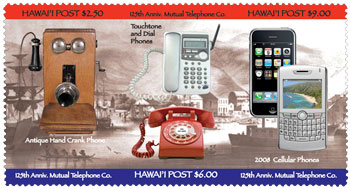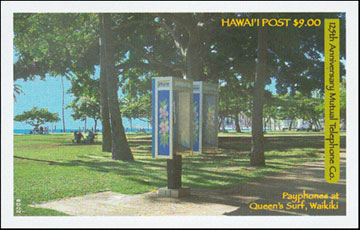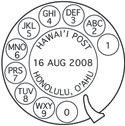.
.
.
.
.
.
.
.
.
.
.
.
.
.
.
.
.
.
.
.
.
.
.
.
.
.
.
.
.
.
.
.
.
.
.
.
.
.
.
.
.
.
.
.
.
.
.
.
.
.
.
.
.
.
.
.
.
.
.
.
August 16th 2008. 125th Anniversary of the Mutual Telephone Company, Hawai'i.
Three stamps in a triptych and a mini-sheet were issued on August 16th 2008 commemorating the 125th Anniversary of the establishment of the Mutual Telephone Company in Hawai'i.
The first two telephones installed in Hawai'i were by Charles Dickey on Maui in 1877. However this was purely a private arrangement between his home in Haiku and his store in Makawao, a distance of 5 miles, using equipment imported from Europe. In 1878, Dickey extended the line to Wailuku and Lahaina, Maui and with a partner formed the "Hawaiian Telegraph Company". It wasn't until 1881 that the "Hawaiian Bell Telephone Company" was started on O'ahu by overseas investors. This company was very slow in expanding due to their high rates.
On August 16 1883 a charter was granted by King Kalakaua to the "Mutual Telephone Company" which promptly offered lower rates and expanded rapidly. However there was no telephone connection between the 2 companies and subcribers had to get a phone form each company. Phone companies were also established on the other Hawaiian islands.
This problem of connectivity was solved on September 24 1894, when the Mutual Telephone Company bought out the Hawaiian Bell Telephone Company. However, without the competition, the subscribers suffered as Mutual raised their rates. After the merger, Hawaii's first telephone directory was published with about 1,100 names on O'ahu. The first Yellow Pages directory appeared in April 1914 as a "Classified Business List".

In 1903, the automatic dial switch was invented which was then applied to phones.This revolutionized the phone system as the operator was now no longer necessary for connecting most calls. Phones in Honolulu were all converted to the dial system in August 1910, although some remained in outlying areas until as late as the 1950's.
On November 2 1931, the first inter-island radio telephone was introduced. In the same year, a mainland radio telephone link was also introduced. In 1935, the first pay phones were installed in Honolulu. On October 8 1957, subscribers were able to make phone calls via the submarine cable which ran from Waikiki to the mainland. On May 5 1986, the first official phone call in Hawaii from a cellular phone was made.
In modern days, Mutual went through a number of name changes. In 1954, it changed its name to the "Hawaiian Telephone Company". In 1967, the GTE Corporation bought the company, and named it "GTE Hawaiian Tel". The most recent name is "Hawaiian Telcom".
----------------------
The triptych issued has three stamps in a continuous design. The background is from a sepia print depicting Honolulu Harbor around the time that the first telephone came to the Hawaiian Islands in the late 1800's.
The $2.50 stamp (top left) shows an antique hand crank phone from the late 19th century. There was no dial or touch pad. First you cranked the handle and then you put the ear piece to your ear and spoke into the mouthpiece to the operator. The operator had to connect each of your phone calls.
The $6 stamp (top middle) shows a dial phone at the bottom. Each number had to be dialed. Using your forefinger you inserted it into the circular hole above the number/letters you wanted and then pulled the dial as far around to the right as you could go, then released it. The dial would automatically return to the start position (see postmark below). The top, more modern telephone uses a touch pad. Each different number/letters pressed yields a different tone. The group of tones were then sent down the telephone line to an exchange where it was automaticlly switched to the right connection. The antenna (on the right) is for a remote extension, usually in another room of your house.
The $9 stamp (top right) shows two different modern cellular (mobile) phones, so-called "smart phones". Numbers are dialled by using typewriter-like buttons or using a touch screen. They also have many other functions such as playing music or taking photos with a built-in camera, plus email and web browsing capabilities. The scene on the lower cell phone is a view of Hanauma Bay on O'ahu.

The $9 minisheet (above) prepays the Same Day rate. It shows two payphones at Queen's Surf, Waikiki Beach. They are becoming scarcer to find these days as so many people now have their own cellular (mobile) phones.

The special postmark for this issue shows a rotary dial on an old-style telephone, as shown at the bottom of the $6 stamp (above).
WE ACCEPT CREDIT CARDS ON ALL ORDERS
![]()
![]()
![]()
![]()
Technical details of the stamps and mini-sheet:
Colors: $2.50, $6 & $9 stamps in a triptych and a $9 mini-sheet - Multicolored
Size: 75mm x 62mm (mini-sheet)
Stamps sheet size: 8 triptychs (2 across, 4 down).
Perforation: Stamps - perf 12. Mini-sheet - imperforate.
Stamps and Mini-sheet design: Enelani.
Layout & Pre-press: Enelani.
Printer: Hawai'i Security Printers, Honolulu, Hawai'i.
Printing Method: 4-color (Cyan, Magenta, Yellow and Black) printing process.
Sheet margin markings: HAWAI'I POST (top middle), "Traffic Light" showing 4 colors used in printing (lower left side), © 2008 Hawai'i Post (lower right side) & Hawai'i Security Printers, Honolulu, Hawai'i. (bottom middle)
Paper: GPA coated white stock with water-activated gum on the back.
The phones depicted in the stamp images are generic and do not contain any company logos or any other copyrighted or trademarked material.
Return to list of stamp issues
For details on upcoming stamp issues click here